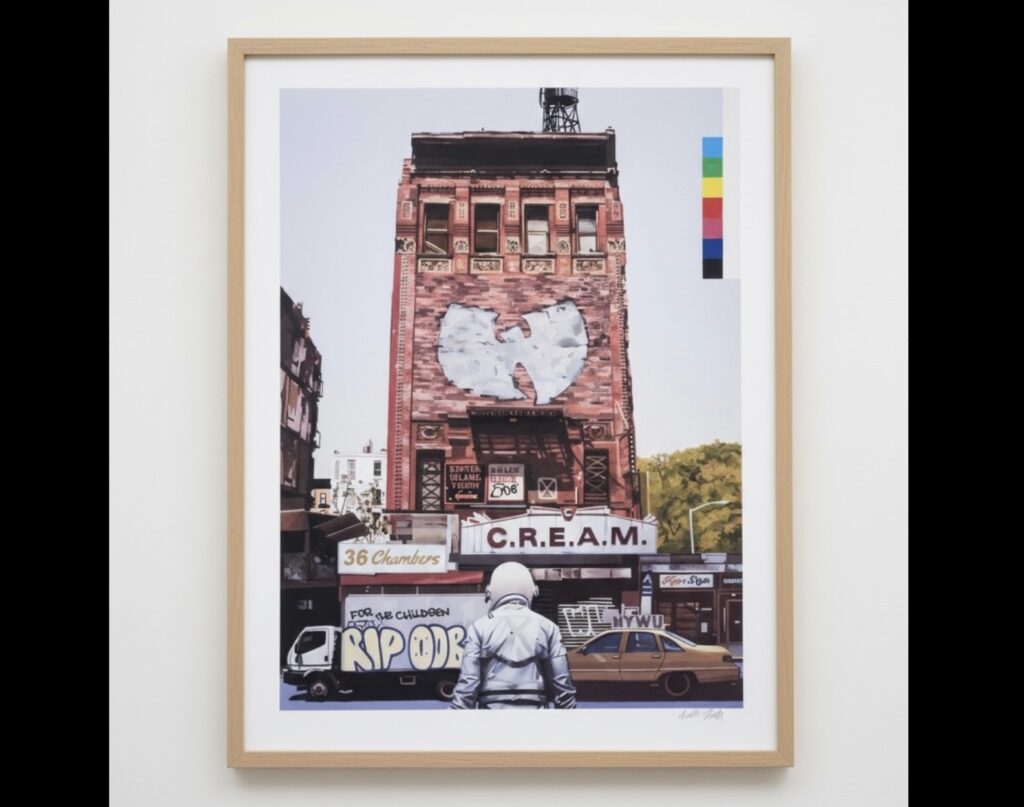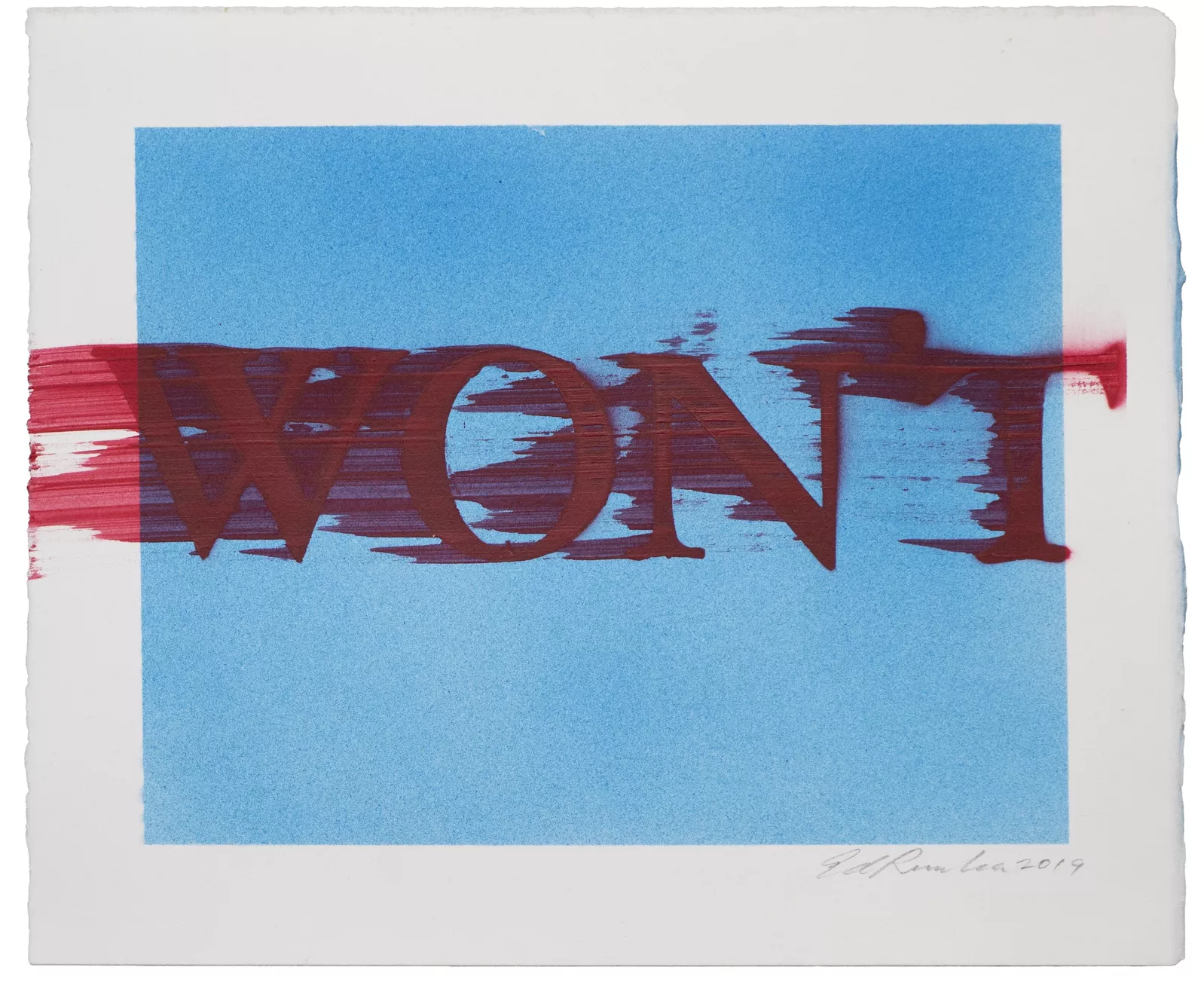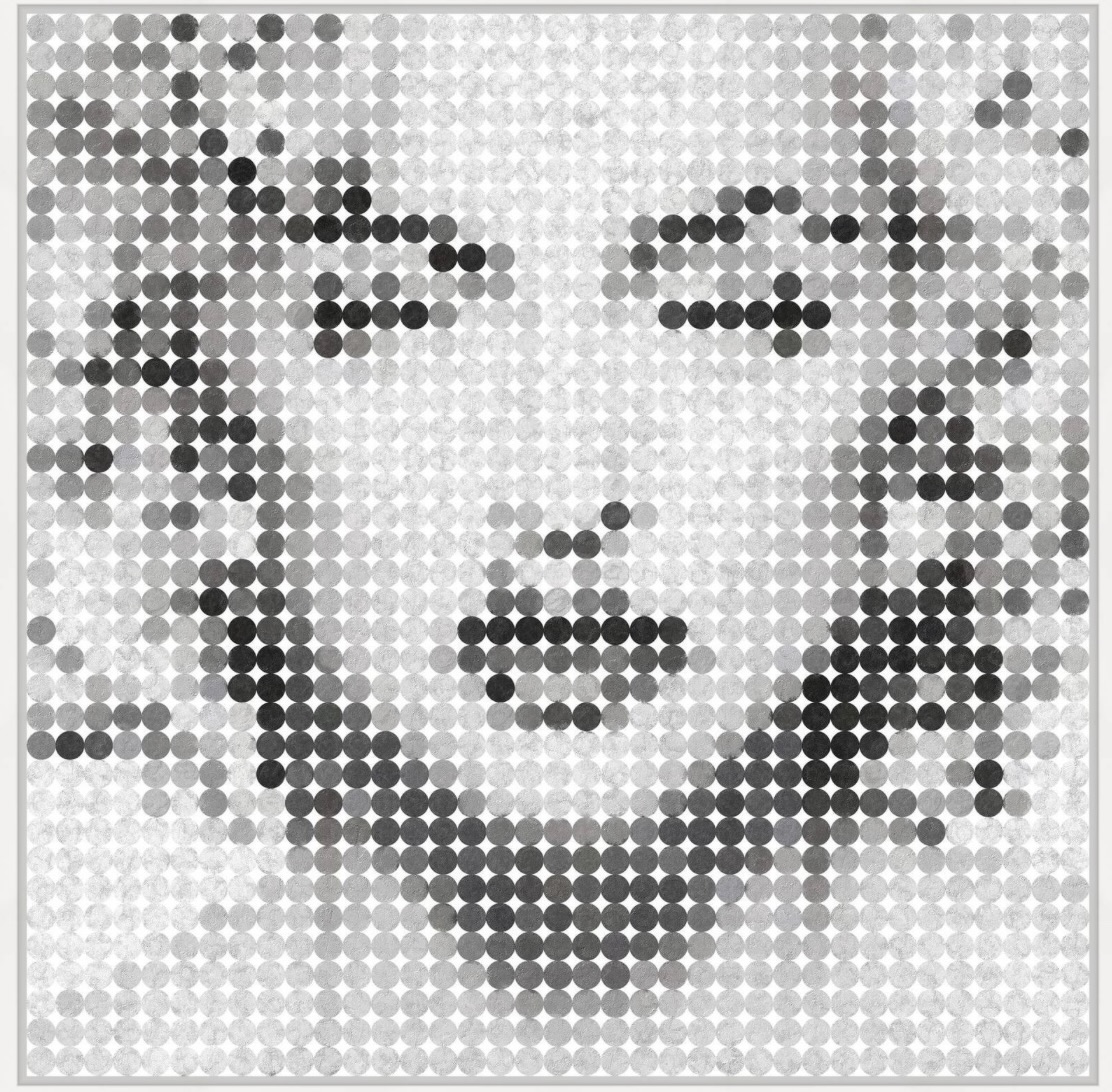In Scott Listfield’s world, the future always looks a little like the past. His latest limited-edition print—a surreal vision of an astronaut standing before a building marked with the Wu-Tang Clan’s unmistakable “W”—is a study in cultural layering, nostalgia, and the permanence of icons. The painting, titled C.R.E.A.M., blends the mythology of hip-hop’s most revered collective with Listfield’s recurring motif: the lone astronaut wandering through a world saturated by memory, media, and the ruins of 20th-century pop culture.
At first glance, the piece feels like a photograph of a forgotten block in New York City—a brick façade, painted signage, and the golden light of an early fall afternoon. But on closer inspection, the astronaut turns the scene into something else: a meditation on how cultural symbols outlive their time, suspended between past glory and present reverence.
an astronaut in the neighborhood
Scott Listfield has long been recognized for his use of a solitary astronaut as both protagonist and witness. Since the late 1990s, this figure has appeared across cityscapes, deserts, and cinematic backdrops—an observer moving through the ruins of modernity, looking at what we’ve built, what we’ve abandoned, and what we continue to worship.
In C.R.E.A.M., the astronaut stands at street level, his white suit pristine against the rough brickwork and urban texture. He faces a building whose façade has become an altar to hip-hop history. Painted across its upper half is the Wu-Tang Clan insignia, faded yet unmistakable, symbolizing both legacy and endurance. The letters “C.R.E.A.M.” appear across the awning below—a direct reference to the group’s 1993 anthem Cash Rules Everything Around Me, one of the most culturally charged statements in hip-hop history.
But Listfield’s astronaut doesn’t belong to this era. He comes from somewhere beyond—perhaps the future, perhaps a parallel reality—confronting a relic of a time when music, rebellion, and street art were intertwined. In his stillness, he becomes a mirror for the viewer’s own reflection on how these symbols, born from rebellion and survival, have evolved into revered artifacts.
a visual
The setting itself—marked with signs reading 36 Chambers and graffiti scrawled “For the Children”—feels like a collage of Wu-Tang’s universe. These references connect to Enter the Wu-Tang (36 Chambers), the collective’s seminal 1993 album that redefined East Coast rap. The imagery isn’t just nostalgic; it’s architectural. The building, weathered and monumental, serves as a metaphor for hip-hop’s permanence in cultural history.
Listfield has always been drawn to icons. In previous works, his astronaut has stood before billboards of King Kong, neon McDonald’s arches, or film posters that shaped collective imagination. In C.R.E.A.M., he turns his lens toward the visual language of hip-hop. This is not graffiti for rebellion’s sake—it’s cultural preservation. The faded walls are reminders that while time erodes everything physical, meaning often survives in collective consciousness.
The artist’s decision to place the astronaut within this space does more than merge two worlds; it collapses the distance between exploration and observation, between the infinite and the intimate. The astronaut becomes a symbol of curiosity—a stand-in for the viewer—facing an urban landscape rich with coded memory.
the intersection
Listfield’s painting style blurs realism with surrealism. Every detail—the cracked signage, the vintage taxi cab, the muted sky—feels authentic, grounded in the documentary precision of urban photography. Yet the astronaut disrupts that realism. He is both alien and familiar, out of place yet perfectly centered. The scene feels paused, as if caught between two eras: one analog and raw, the other digital and distant.
In many of Listfield’s works, the astronaut navigates spaces devoid of people, reinforcing the eerie solitude of a world consumed by its artifacts. Here, however, the presence of the Wu-Tang iconography injects vitality. The street is quiet, but it hums with cultural noise—a thousand echoes of beats, verses, and lives lived to the rhythm of survival.
The CMYK color bars printed along the side—a recurring detail in Listfield’s edition works—add another layer of meaning. They hint at the mechanics of reproduction, the act of printing and distribution, perhaps even commercialization. The bars remind us that culture, once underground, now lives in galleries, online shops, and haute apartments. It’s an unspoken commentary on how subculture becomes aesthetic—how rebellion becomes collectible.
a monument
The astronaut’s posture—facing forward, arms slightly bent—suggests contemplation rather than conquest. He’s not exploring new worlds but returning to an old one, rediscovering what we’ve left behind. In that sense, C.R.E.A.M. becomes a memorial, not to loss, but to transformation.
The work draws upon Listfield’s ongoing fascination with human legacy. He paints like an anthropologist of pop culture, documenting the physical spaces where meaning once lived: abandoned malls, faded movie sets, forgotten murals. By placing his astronaut amid these environments, he invites us to reflect on how art, commerce, and identity overlap—and how our shared symbols can both connect and outlast us.
The Wu-Tang references, layered with graffiti tags and urban decay, are not purely nostalgic—they’re archeological. Each element becomes a data point in the cultural sediment of modern America. The piece feels alive, not because it depicts motion, but because it captures the pulse of history through stillness.
flow
What’s remarkable about C.R.E.A.M. is its ability to elevate local mythology into universal symbolism. The Wu-Tang Clan’s roots in Staten Island’s housing projects are worlds away from the sterile isolation of an astronaut’s suit, yet Listfield finds common ground between them: both represent exploration, survival, and the forging of new languages from adversity.
There’s poetry in that juxtaposition—the astronaut, a vessel of science and progress, standing before an emblem of raw creativity and resistance. Together they suggest that culture and exploration are intertwined pursuits. Hip-hop, like space travel, emerged from limitation and curiosity, from the urge to see beyond one’s environment.
the print as artifact
As a limited-edition print, C.R.E.A.M. embodies Listfield’s sensitivity to physical media. The precision of its framing, the crispness of the pigment print, and the neutral tone of the wooden border all reinforce the tension between street and studio, between impermanence and preservation.
By freezing a moment of urban iconography, Listfield turns a piece of cultural ephemera into fine art. The inclusion of the color calibration marks on the edge acts as both a technical note and a conceptual device—it acknowledges that this image, like all images, is a reproduction. The artist invites the viewer to see not just what is depicted, but how it’s made, distributed, and consumed.
impression
Scott Listfield’s C.R.E.A.M. is more than homage—it’s a philosophical loop, connecting the past’s creative resistance with the future’s detached curiosity. The astronaut, our recurring proxy for reflection, stands in quiet reverence before a monument to art born from struggle.
Listfield’s work continues to remind us that the culture we build—whether through beats, walls, or pixels—outlasts us. And as his astronaut gazes up at the faded Wu-Tang emblem, the scene becomes a prophecy: that even in the future, the language of the street, the rhythm of rebellion, and the echoes of C.R.E.A.M. will remain.
No comments yet.








